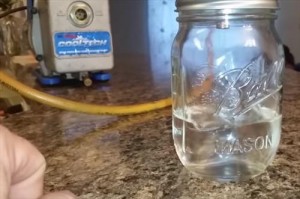The thoroughness of the evacuation process and the universal application of a high-vacuum pump is accepted as the most sound investment for field and shop use in refrigeration service work. So that the great value of a high-vacuum pump can be appreciated, let us review the fundamentals involved in the operation of the vacuum pump and its economical evacuation.
To remove some of the mystery that seems to accompany the word vacuum, we will discuss how a vacuum pump pumps. It is no problem for us to understand how a liquid pump operates because we can see and measure the sub-stance being pumped and the amount of liquid being discharged. It is a different story, however, when a vacuum pump is operating; there is no visible sign that the work is actually being accomplished. We must depend on the gauge indication. The selection of the type of gauge to use is just about as important as the type of vacuum pump.
In our everyday lives we have learned that every-thing in nature seeks an equilibrium of pressure. As an example, when an automobile tire blows out, the air rushes from inside the tire to the atmosphere where the pressure is lower. This difference in pressure causes the air to seek an equilibrium of pressure. Any time there is a greater pressure in one area than in another this differential in pressure exists. When an automobile tire has a slow leak, a greater amount of time is required for the equilibrium to take place. When we remember this differential in pressure, we can see the importance of a high-vacuum pump, as well as the use of a large-diameter connecting line. The purpose of a vacuum pump is to remove contaminants from inside a closed system, thus reducing the pressure inside the system. To cause the mixture of gases to flow from inside the system to the pump, the pump must create a sufficiently lower pressure inside its cylinder than the one inside the system being evacuated.
When a pump reaches the point where the pressure differential is no longer great enough to cause this flow, a state of equilibrium is present, the flow of gases stops, and the pressure inside the system is no longer decreased. When this state of equilibrium is reached, it is referred to as the “blank-off pressure” of the pump.
An advantage of having a high-vacuum pump in good condition is that a very low blank-off pressure can be reached, thus creating a large differential in pressure. This large pressure differential determines that the high-vacuum pump has a faster pump-down than a low-vacuum pump.
The most economical investment in modern evacuation equipment is not in the purchase of a high-vacuum pump alone but the investment in two additional time-saving accessories. These two accessories are a two-valved high-vacuum test manifold and an electronic high-vacuum gauge having a range from 0 to at least 20 mm Hg. The combination of these three components is applicable to all pumping units that are used either in the field or in the shop or for small service stations.
A vacuum system made of these components will save many hours by continuously providing information about the progress of the system pump-down. These types of instruments will give confidence that the evacuation meets the modern requirements and furnishes complete quality control of the process.
